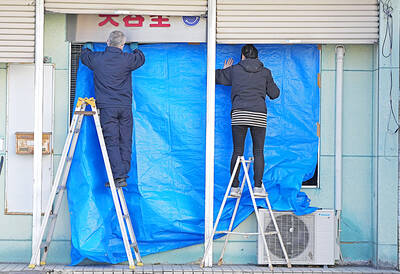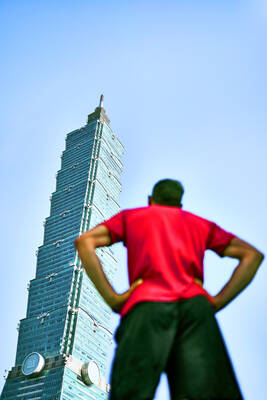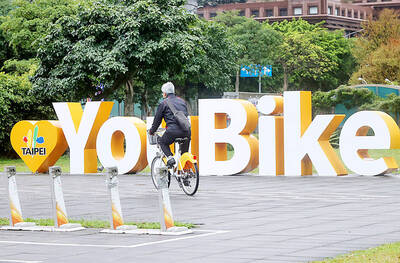As the drought continues to deplete water in Taiwan's reservoirs, political figures, lawmakers, water managers and experts are rushing to find innovative ways to increase water supplies. When talking about increasing water supplies, most of them soon discovered that debating the necessity of building new reservoirs was inevitable.
"Abandoning the idea of building new large reservoirs is a world trend. Building more dams is like drinking poison to quench a thirst," DPP Legislator Chiu Chuang-chin (邱創進) said at the Legislative Yuan on May 9.
Chiu argued that water officials should adopt innovative ideas, such as building underground reservoirs (地下水庫), to avoid environmental deterioration caused by the construction of dams.
Chiu objected to building new reservoirs in a bid to force water resources managers to review existing policies.
When the nation is not experiencing any difficulties, more than 40 reservoirs, which can store 4.2 billion tonnes of water, supply 11.6 million tonnes of water per day.
Under the circumstances, the Water Resource Agency is planning to build at least six new large reservoirs beginning in 2005. The agency estimates that supplies from five of the six reservoirs will increase the amount of water available by 16 percent when they are completed in 2014. The capacity of the sixth reservoir has not yet been assessed.
The agency's intention to build six new reservoirs, costing NT$13 billion, was criticized by PFP Legislator Chou Hsi-wei (周錫偉) and others on May 6 at the Legislative Yuan. Chou said that the reservoirs would not solve the existing problems because the first dam would not be completed until 2008.
For water-resources management officials, seeking new water supply sources is more important than cutting demand or raising prices.
KMT Chairman Lien Chan (
Lien argued that building more dams would ensure reliable water supplies, saying the Meinung Dam project was put aside due to the DPP government's ignorance of water-resources management.
Before the DPP became the ruling party in 2000, the KMT-led central government encouraged reservoir construction. The project in Meinung township has encountered strong local opposition since the early 1990s.
Controversial issues pertaining to environmental justice, Hakka cultural conservation, ecological preservation and geological threats made it impossible for the KMT-led government to complete the project.
Anti-dam activists argued that the dam was being built not because it could solve water shortages for local residents in southern Taiwan, but because of demand from the industrial sector.
Although the economics minstry projects for building six reservoirs exclude the Meinung Dam project, legislators and anti-dam activists have objected to the projects.
"Contradictory policies should be reviewed," DPP Legislator Tsao Chi-hung (
Tsao, who established the Pingtung?based Blue Tunkang River Conservation Association (藍色東港溪保育協會), also urged the government to back underground reservoir projects.
At the press conference, Ting Cheh-shyh (丁澈士), a professor at the National Pingtung University of Science and Technology, said that building underground reservoirs has preserved water resources in the US and some European countries such as the Netherlands.
According to Ting, the Aquifer Storage Recovery method works by storing water during times of flood or when water quality is good and recovering it later during emergencies, or when water quality from the primary source is poor.
"The concept is similar to depositing money in a bank account and withdrawing it when we need it," Ting said.
Through artificial lakes or deep wells, Ting said, pre-treated, clean stream water is injected into underground reservoirs further downstream.
Ting said that a water supply company, which injects clean water into a 900-hectare coastal area near The Hague, demonstrated that it can meet water demands for a population of 1.2 million.
Ting is conducting an on-site research project on a 300-hectare area of the alluvial fan formed by the Linbian River (
Lin estimates that 100 million tonnes of water would be preserved by the underground reservoir each year.
"This method could be used at other places with similar geological conditions in Taiwan," said Ting.
Water-resources officials told the Taipei Times last week that options for building new large reservoirs in Taiwan are limited. The situation, officials said, has forced them to consider other methods of preserving water supplies.
"Actually we've considered supporting similar projects in other places, such as the Choshui River (濁水溪) in central Taiwan and the Lanyang River (蘭陽溪) in eastern Taiwan," said Chen Shen-hsien (陳伸賢), spokesman and deputy director of the Water Resources Agency.

Taiwanese were praised for their composure after a video filmed by Taiwanese tourists capturing the moment a magnitude 7.5 earthquake struck Japan’s Aomori Prefecture went viral on social media. The video shows a hotel room shaking violently amid Monday’s quake, with objects falling to the ground. Two Taiwanese began filming with their mobile phones, while two others held the sides of a TV to prevent it from falling. When the shaking stopped, the pair calmly took down the TV and laid it flat on a tatami mat, the video shows. The video also captured the group talking about the safety of their companions bathing

US climber Alex Honnold is to attempt to scale Taipei 101 without a rope and harness in a live Netflix special on Jan. 24, the streaming platform announced on Wednesday. Accounting for the time difference, the two-hour broadcast of Honnold’s climb, called Skyscraper Live, is to air on Jan. 23 in the US, Netflix said in a statement. Honnold, 40, was the first person ever to free solo climb the 900m El Capitan rock formation in Yosemite National Park — a feat that was recorded and later made into the 2018 documentary film Free Solo. Netflix previewed Skyscraper Live in October, after videos

Starting on Jan. 1, YouBike riders must have insurance to use the service, and a six-month trial of NT$5 coupons under certain conditions would be implemented to balance bike shortages, a joint statement from transportation departments across Taipei, New Taipei City and Taoyuan announced yesterday. The rental bike system operator said that coupons would be offered to riders to rent bikes from full stations, for riders who take out an electric-assisted bike from a full station, and for riders who return a bike to an empty station. All riders with YouBike accounts are automatically eligible for the program, and each membership account

A classified Pentagon-produced, multiyear assessment — the Overmatch brief — highlighted unreported Chinese capabilities to destroy US military assets and identified US supply chain choke points, painting a disturbing picture of waning US military might, a New York Times editorial published on Monday said. US Secretary of Defense Pete Hegseth’s comments in November last year that “we lose every time” in Pentagon-conducted war games pitting the US against China further highlighted the uncertainty about the US’ capability to intervene in the event of a Chinese invasion of Taiwan. “It shows the Pentagon’s overreliance on expensive, vulnerable weapons as adversaries field cheap, technologically